Morphology of Flowering Plants
Maharashtra Board-Class-11-Science-Biology-Chapter-9
Notes-Part-1
|
Topics to be Learn : Part-1
|
Angiosperms :
Angiosperms are one of flowering plants from phanerogams.
Angiosperms can be classified into following types on the basis of habitat.
- Hydrophytes - Growing in aquatic habitat e.g. Hydrilla
- Xerophytes - Growing in regions with scanty or no rainfall like desert e.g. Opuntia
- Psammophytes - Growing in sandy soil e.g. Elymus ‘
- Lithophytes - Growing on rock e.g. Paphiopedilum orchids rock felt fern
- Halophytes - Growing in saline soil e.g. Mangrove plants like Rhizophora
Morphology :
Morphologically plant shows
- Vegetative structures : root, stem, leaf
- Reproductive structures : flowers, fruits and seeds.
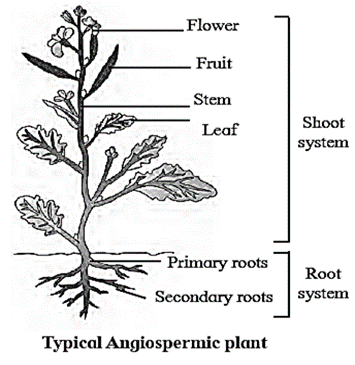
(A) Root :
- Root is descending axis of plant body
- Root is positively geotropic and hydrotropic but negatively phototropic and aerotropic.
- Root grows beneath the soil surface towards gravity.
- Roots are generally non-green, cylindrical and without nodes and internodes.
Typical Root Structure :
A typical root has different regions :- Root cap: A parenchymatous multicellular structure in the form of cap, present over young growing root apex is known as root cap. Meristematic region or region of cell division: The apex of the root is a growing point about 1 mm in length protected by root cap. This region is called as region of cell division or meristematic region. Region of elongation : Region of root hair or region of absorption: Region of maturation/region of differentiation:
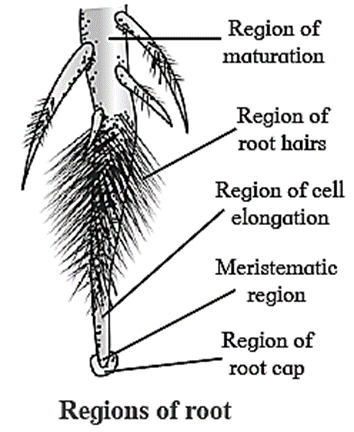
Function of Root :
- Primary functions of root are,
- Fixation or anchorage of plant body in the soil,
- Absorption of water and minerals from soil
- Conduction of absorbed materials up to the stem base etc.
Types of Root :
On the basis of origin, roots can be classified as Tap roots or true roots and Adventitious roots.
(i) Tap root :
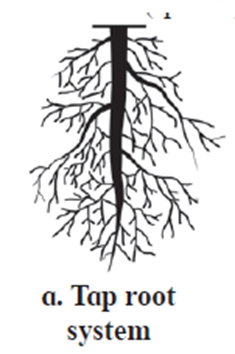
- It arises from radicle of an embryo during seed germination
- It is differentiated into primary, secondary and teritary roots
- The main root is called as primary root. Its branches of first order are called as secondary roots Branches of second order are called as tertiary roots e.g. Pea, Bean, Sunflower etc.
- The main root is very thick as compared to others.
- Tap root system is commonly seen in dicotyledonous plants.
(ii) Adventitious root :

- Adventitious root system is found in plants like maize, wheat and sugarcane.
- Adventitious root develops from any part other than radicle.
- Such roots may develop from the base of the stem, nodes or from leaves.-
- In monocots, radicle is short lived.
- A thick cluster of equal sized roots arise from the base of a stem. It is also known as fibrous root system as they look like fibre. The growth of roots is superficial.
- Adventitious roots in some plants are used for vegetative propagation. E.g. Euphorbia, Carapichea ipecacuanha (Ipecac) etc.
Modification of root :
- Metamorphosed roots : When roots have to perform some special type of function in addition to or instead of their normal function they develop some structural changes. Such roots are called as metamorphosed roots.
Modification of tap root :
(i) Modifications of tap root for food storage : On the basis of shape swollen tap roots are classified as Fusiform, Conical and Napiform.
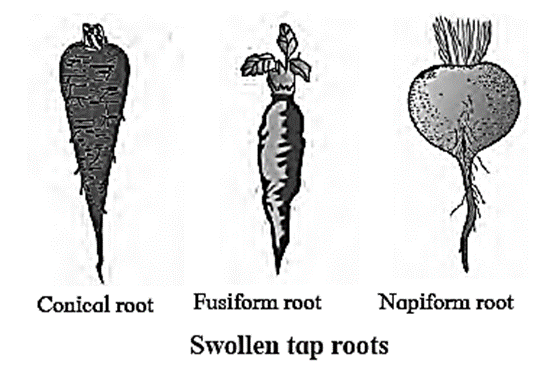
(ii) Modifications of tap root for respiration : Halophytes plants grow in saline swamps, marshy places and salt lakes. The main root system of these plants do not get sufficient air for respiration as soil is water logged. Due to this, mineral absorption of plant also gets affected. To overcome this problem underground roots develop special roots.
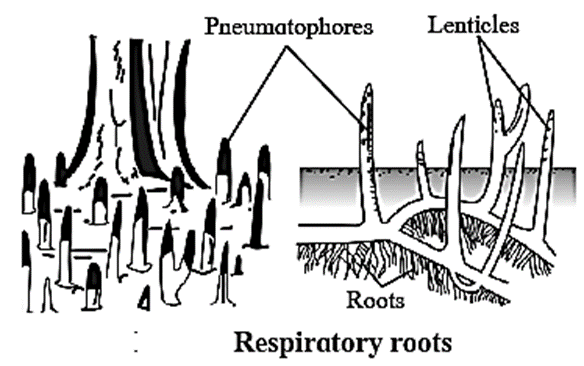
Modifications of Adventitious Roots :
(i) Modifications of adventitious root for food storage : Fibrous roots also show food storage like tap root but the main difference is that fibrous root usually do not develop definite shape. These roots are further classified as Simple tuberous, Fasciculated tuberous, Beaded and Nodulose roots. Simple tuberous root : Fasciculated tuberous roots : Moniliform roots : Nodulose roots :
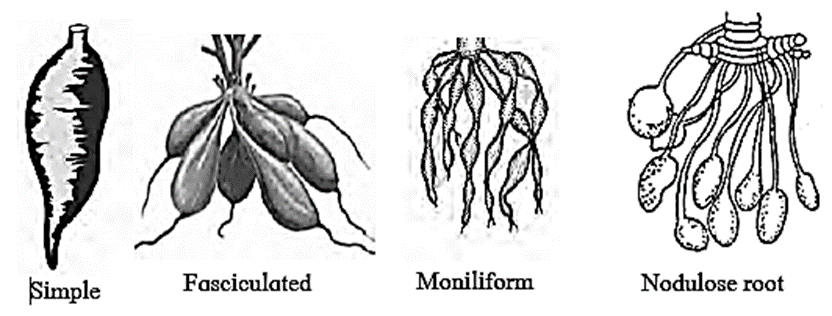
(ii) Modifications of adventitious root for mechanical support :
Prop roots:
- These roots arise from horizontal branches of tree like Banyan tree (Ficus benghalensis) and grow vertically downwards till they penetrate the soil.
- These prop roots show secondary growth, become thick, act like pillars to provide mechanical support to the heavy branches.
Stilt roots:
- These roots normally arise from a few lower nodes of a weak stem in some monocots, shrubs and small trees
- They show obliquely downward growth penetrating soil and provide mechanical support to the plant.
- In the members of family Poaceae, the plants like Maize, Jowar, Sugarcane etc. produce stilt root in whorl around the node.
- These roots provide additional support to the plant body.
- In Screw pine or Pandanus (Kewada), stilt roots arise only from the lower surface of obliquely growing stem for additional support. These roots show multiple root caps.
Climbing roots:
- Different climbers with weak stem produce roots at their nodes by means of which they attach themselves to support and thereby raise themselves above the ground.
- e.g. Betel leaf or Pan, black pepper or Piper nigrum (Kali Mirch), Pothos or money plant.
Clinging roots:
- These tiny roots develop along intemodes, show disc at tips, which exude sticky substance.
- This substance enables plant to get attached with walls of buildings.
- They do not damage substratum.
- e.g. English Ivy (Hedera helix). -
Plank roots/Buttress:
- These roots often develop at the base of large trees and form plank like extensions around stem.
- These roots provide additional support.
- e.g. Silk cotton, Peepal, etc.
Buoyant roots:
- Roots developed at the nodes of aquatic herbs like (Jussiaea repens), become highly inflated and Spongy providing buoyancy and helping the plant to float.
(iv) Modifications of adventitious root for special function : Epiphytic roots : Sucking roots or Haustoria :
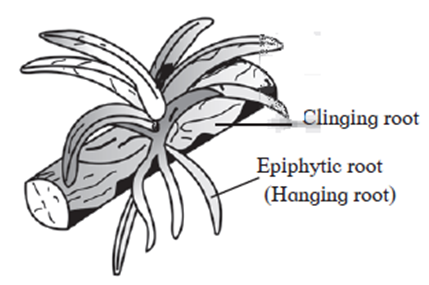
Stem :
The primary functions of the stem are to produce and support branches, leaves, flowers and fruits; conduction of water and minerals and transportation of food to plant parts.
Characteristics of stem:
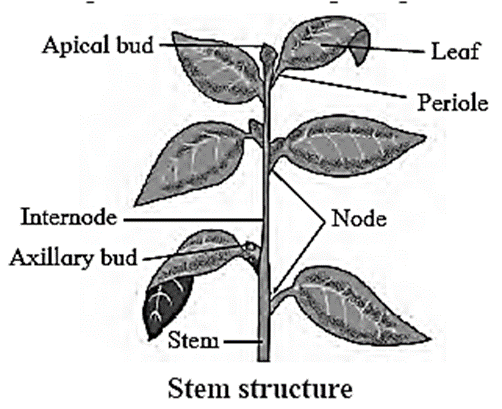
Modifications of stem :
Stem develops some modifications for additional or accessory functions. To perform such function stem shows different modifications :
Underground stem :
In some herbaceous plants the stem which develops below soil surface is called underground stem.
- The underground stem remains dormant during unfavourable condition and on the advent of favourable condition produces aerial shoots.
- Underground stems are modified to perform different functions like storage of food, perennation and vegetative propagation. However, they differ from root in having nodes and internodes.
Rhizome :
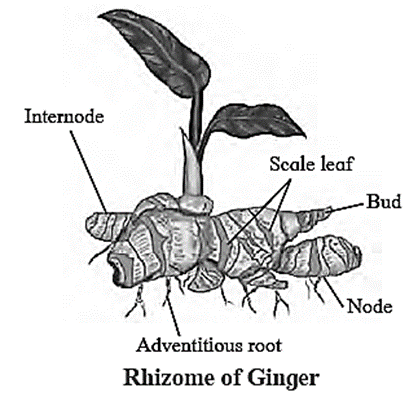
Stem Tuber :
- Potato is a stem tuber.
- It is an underground stem, modified for storage of food material.
- Special underground branches of stem at their tips becomes swollen due to storage of food which is mostly starch.
- Stem tuber shows distinct nodes, but not internodes hence it is classified as stem. '
- At nodal part, it shows scale leaves with axillary buds, which are commonly called as ‘eyes’.
- Under favourable conditions, ‘eyes’ can produce aerial shoots.
- Potato tuber can be propagated vegetatively.
[Note: In stem tuber, internodes are present but they are not very distinct]
Bulb : The bulb is of different types

Corm :
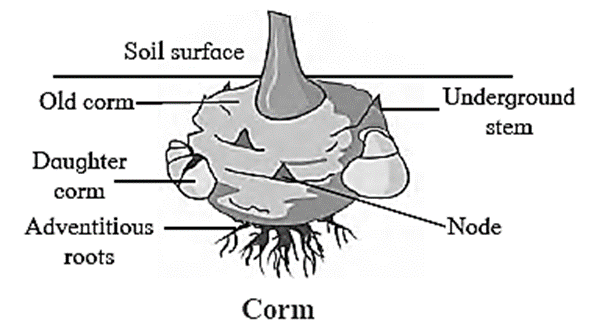
Sub aerial stems:
- These are generally weak or straggling stems growing over the ground and need support for perpetuation.
- Sometimes these stems are found to grow beneath the soil surface also. Thus, they show contact with both air and soil.
- Sub aerial stems are meant for perennation and vegetative propagation.
- Scale leaves and axillary buds are present over stem surface. Axillary buds develop into aerial shoots.
Types of sub aerial stems: (i) Trailer: (ii) Runner: (iii) Stolons : (iv) Sucker: (v) Offset:
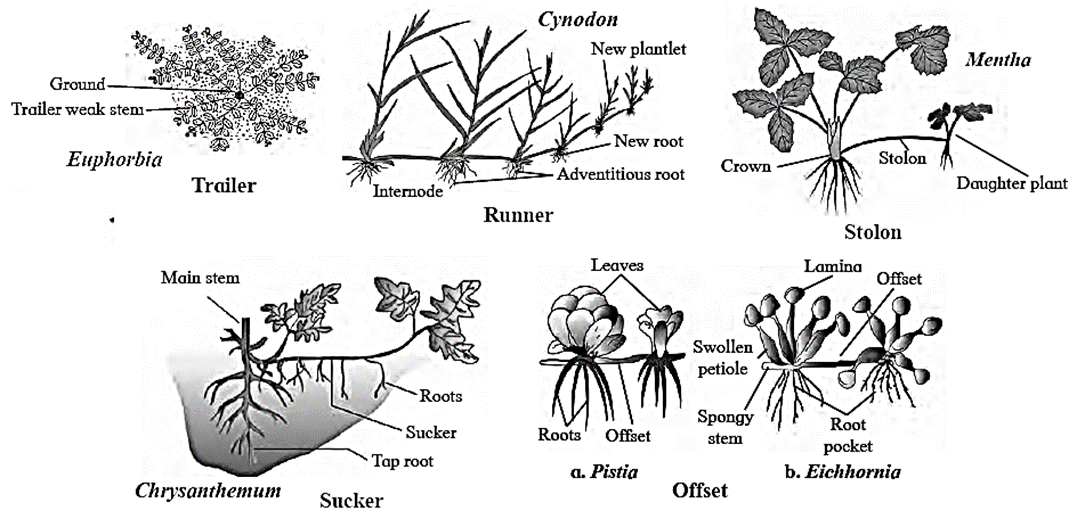
Aerial modification :
Stem or it's vegetative part modify to carry out specialized functions. Such modified stems are called as metamorphosed stems.
The different modifications as given below:
Thorn:
- It is modification of apical or axillary bud.
- Thom is hard pointed and mostly straight structure (except Bougainvillea where it is curved and useful for climbing).
- It provides protection against browsing animals and also helps in reducing transpiration.
- Apical bud develops into thorn in Carrisa whereas axillary bud develops into thorn in Duranta, Citrus, Bougainvillea, etc.
Phylloclade:
- Modification of stem into leaf like photosynthetic organ is known as phylloclade.
- Being stem it possesses nodes and internodes.
- It is thick, fleshy and succulent, contains mucilage for retaining water e.g. Opuntia, Casuarina (‘Cylindrical shaped phylloclade) and Muehlenbeckia (ribbon like phylloclade).
Cladodes:
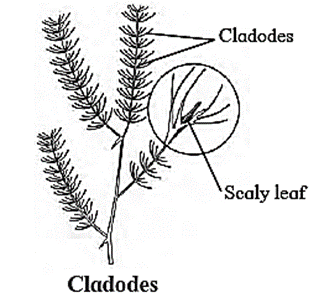
Cladophylls :
- These are leaf like structures bore in the axil of scale leaf.
- It has floral bud and scale leaf in the middle i.e. upper half is leaf and lower half is stem.
- It helps in photosynthesis e.g. Ruscus.
Bulbils:
- In plants like Agave, Dioscorea, etc. axillary bud becomes fleshy and rounded due to storage of food called as bulbil.
- When it falls off it produces new plant and help in vegetative propagation.
Stem tendrils: 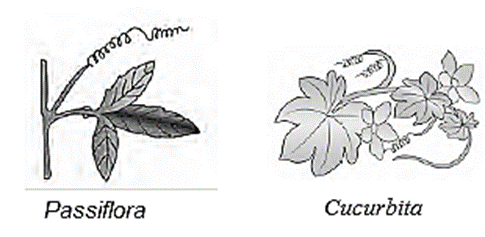
Q. Why the stem has to perform photosynthesis in xerophytes?
Main Page : – Maharashtra Board Class 11th-Biology – All chapters notes, solutions, videos, test, pdf.
Previous Chapter : Chapter-8- Plant Tissues and Anatomy – Online Notes
Next Chapter : Chapter-10-Animal Tissues – Online Notes
We reply to valid query.